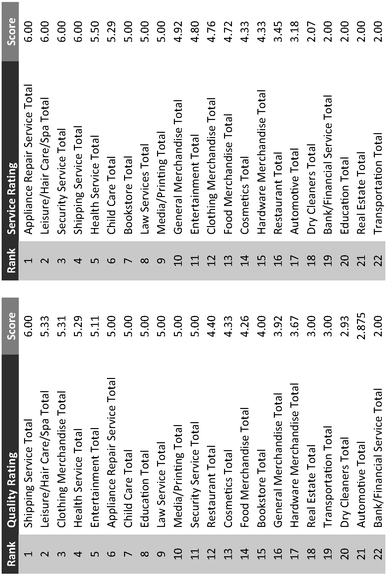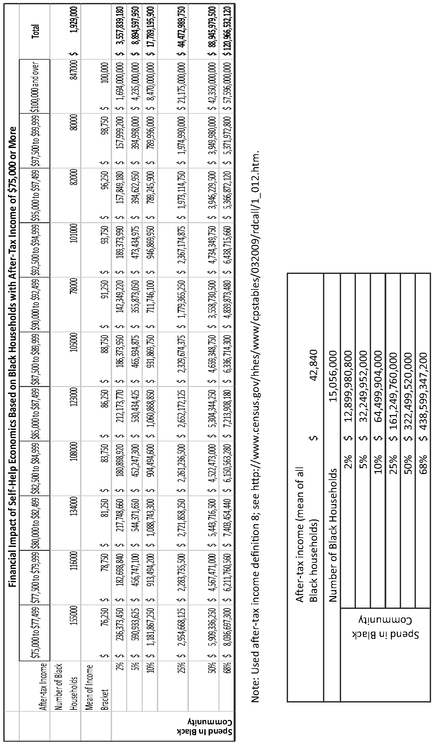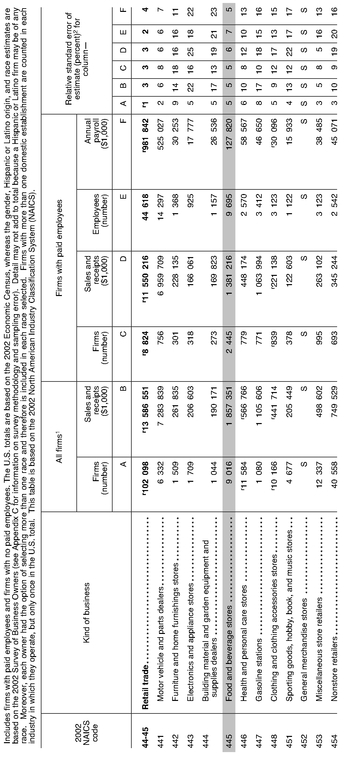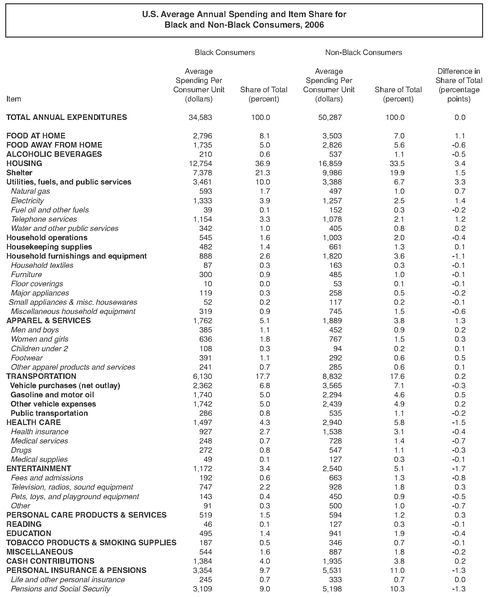Our Black Year (40 page)
Authors: Maggie Anderson

Â
APPENDIX 4 Complete Breakout of Rankings by Industry

Â
| Products/Services | ($Billion) | % |
|---|---|---|
| Housing and Related Charges | $166.30 | 33.21% |
| Education | $71.00 | 14.18% |
| Food | $65.30 | 13.04% |
| Cars and TrucksâNew and Used | $31.50 | 6.29% |
| Apparel Products and Services | $26.90 | 5.37% |
| Health Care | $23.90 | 4.77% |
| Insurance | $19.00 | 3.79% |
| Telephone Services | $17.20 | 3.44% |
| Household Furnishings and Equipment | $12.90 | 2.58% |
| Contributions | $11.00 | 2.20% |
| Media | $8.30 | 1.66% |
| Personal Care Products and Services | $6.60 | 1.32% |
| Travel, Transportation, and Lodging | $6.40 | 1.28% |
| Consumer Electronics | $4.50 | 0.90% |
| Miscellaneous | $4.40 | 0.88% |
| Computers | $3.50 | 0.70% |
| Gifts | $3.50 | 0.70% |
| Beverages (Nonalcoholic) | $3.10 | 0.62% |
| Tobacco Products and Smoking Supplies | $3.10 | 0.62% |
| Beverages (Alcoholic) | $2.80 | 0.56% |
| Entertainment and Leisure | $2.80 | 0.56% |
| Toys, Games, and Pets | $2.40 | 0.48% |
| Appliances | $2.20 | 0.44% |
| Sports and Recreational Equipment | $1.00 | 0.20% |
| Housewares | $0.80 | 0.17% |
| Books | $0.30 | 0.06% |
| Total | $500.70 |
Â
APPENDIX 6 Calculation of Impact Potential of After-tax Spending in the Black Community

Â
APPENDIX 7 Black-Owned Retail Businesses, 2002
Source:
Survey of Business Owners, U.S. Census Bureau, 2002 Economic Census.
Survey of Business Owners, U.S. Census Bureau, 2002 Economic Census.

Â
APPENDIX 8 Black Spending by Category
Source: Shares were calculated by the Selig Center for Economic Growth, based on data obtained from the U.S. Department of Labor, Bureau of Labor Statistics, Consumer Expenditure Survey, 2006.

Notes
Introductionxii
it is in African American neighborhoods? Six hours.
... Brooke Stephens,
Talking Dollars and Making Sense: A Wealth-Building Guide for African-Americans
(New York: McGraw-Hill, 1997), 18.
it is in African American neighborhoods? Six hours.
... Brooke Stephens,
Talking Dollars and Making Sense: A Wealth-Building Guide for African-Americans
(New York: McGraw-Hill, 1997), 18.
xii
in this country goes to Black-owned businesses.
... Michael H. Shuman, “Community Entrepreneurship: To Turn Communities Around, Training Programs Must Teach a Double Bottom Line,” National Housing Institute Shelterforce Online, September/October 1999.
in this country goes to Black-owned businesses.
... Michael H. Shuman, “Community Entrepreneurship: To Turn Communities Around, Training Programs Must Teach a Double Bottom Line,” National Housing Institute Shelterforce Online, September/October 1999.
xii
only 7.5 percent of Latinos and 5.1 percent of Blacks.
... Robert W. Fairlie and Alicia M. Robb,
Race and Entrepreneurial Success: Black-, Asian-, and White-Owned Businesses in the United States
(Cambridge, MA: MIT Press, 2008).
only 7.5 percent of Latinos and 5.1 percent of Blacks.
... Robert W. Fairlie and Alicia M. Robb,
Race and Entrepreneurial Success: Black-, Asian-, and White-Owned Businesses in the United States
(Cambridge, MA: MIT Press, 2008).
xii
Black-owned firms? $74,018.
. . . Ibid.
Black-owned firms? $74,018.
. . . Ibid.
xii
which generated 2 percent of the nation's business revenues.
... Shuman, “Community Entrepreneurship.”
which generated 2 percent of the nation's business revenues.
... Shuman, “Community Entrepreneurship.”
xii
groceries, footwear, clothing, and shoes than the overall population
. . . Jeffrey M. Humphreys, “The Multicultural Economy 2008,” Terry College of Business/ Selig Center for Economic Growth, University of Georgia,
http://www.terry.uga.edu/selig/docs/buying_power_2008.pdf
, 7â8.
groceries, footwear, clothing, and shoes than the overall population
. . . Jeffrey M. Humphreys, “The Multicultural Economy 2008,” Terry College of Business/ Selig Center for Economic Growth, University of Georgia,
http://www.terry.uga.edu/selig/docs/buying_power_2008.pdf
, 7â8.
xii
categories of apparel, video game hardware, and PC software.
. . . “African-American /Black Market Profile,” Magazine Publishers of America, 2007,
http://www.magazine.org/ASSETS/2457647D5D0A45F7B1735B8ABCFA3C26/market_profile_black.pdf
, 11.
categories of apparel, video game hardware, and PC software.
. . . “African-American /Black Market Profile,” Magazine Publishers of America, 2007,
http://www.magazine.org/ASSETS/2457647D5D0A45F7B1735B8ABCFA3C26/market_profile_black.pdf
, 11.
xvii
within a year 80 percent of the people diagnosed with the disease.
... Hirshberg Foundation for Pancreatic Cancer Research, “Prognosis of Pancreatic Cancer,”
http://www.pancreatic.org/site/c.htJYJ8MPIwE/b.891917/k.5123/Prognosis_of_Pancreatic_Cancer.htm
.
Chapter 1within a year 80 percent of the people diagnosed with the disease.
... Hirshberg Foundation for Pancreatic Cancer Research, “Prognosis of Pancreatic Cancer,”
http://www.pancreatic.org/site/c.htJYJ8MPIwE/b.891917/k.5123/Prognosis_of_Pancreatic_Cancer.htm
.
1
and some of the highest murder rates in the city.
... ”Austin,” Great Cities Institute Neighborhoods at the University of Illinois at Chicago,
http://www.uicni.org/page.php?section=neighborhoods&subsection=austin
, 1.
and some of the highest murder rates in the city.
... ”Austin,” Great Cities Institute Neighborhoods at the University of Illinois at Chicago,
http://www.uicni.org/page.php?section=neighborhoods&subsection=austin
, 1.
2
Bulldozers cleared away most of the charred ruins.
... Stevenson Swanson, Chicago Tribune,
Chicago Days: 150 Defining Moments in the Life of a Great City
(Chicago: Contemporary Books, 1997), 210â11.
Bulldozers cleared away most of the charred ruins.
... Stevenson Swanson, Chicago Tribune,
Chicago Days: 150 Defining Moments in the Life of a Great City
(Chicago: Contemporary Books, 1997), 210â11.
6
neighborhoods with high need for grocery stores and supermarkets. ”
. . . “Going to Market: New York City's Neighborhood Grocery Store and Supermarket Shortage,” New York City Department of City Planning,
http://www.nyc.gov/html/dcp/html/supermarket/index.shtml
, 2.
neighborhoods with high need for grocery stores and supermarkets. ”
. . . “Going to Market: New York City's Neighborhood Grocery Store and Supermarket Shortage,” New York City Department of City Planning,
http://www.nyc.gov/html/dcp/html/supermarket/index.shtml
, 2.
7
in the
American Journal of Public Health
told a similar story.
. . . Carol R. Horowitz, Kathryn A. Colson, Paul L. Hebert, and Kristie Lancaster, “Barriers to Buying Healthy Foods for People with Diabetes: Evidence of Environmental Disparities,”
American Journal of Public Health
94, no. 9 (September 2004): 1549â54,
http://www.ncbi.nlm.nih.gov/pmc/articles/PMC1448492/
.
in the
American Journal of Public Health
told a similar story.
. . . Carol R. Horowitz, Kathryn A. Colson, Paul L. Hebert, and Kristie Lancaster, “Barriers to Buying Healthy Foods for People with Diabetes: Evidence of Environmental Disparities,”
American Journal of Public Health
94, no. 9 (September 2004): 1549â54,
http://www.ncbi.nlm.nih.gov/pmc/articles/PMC1448492/
.
11
the last couple of decades have exacerbated the problem.
. . . William J. Wilson,
The Declining Significance of Race: Blacks and Changing American Institutions
, 2d ed. (Chicago: University of Chicago Press, 1980).
the last couple of decades have exacerbated the problem.
. . . William J. Wilson,
The Declining Significance of Race: Blacks and Changing American Institutions
, 2d ed. (Chicago: University of Chicago Press, 1980).
11
and they are falling further and further behind.”
. . . “The Two Nations of Black America,”
Frontline
, 1997,
http://www.pbs.org/wgbh/pages/frontline/shows/race/interviews/wilson.html
.
and they are falling further and further behind.”
. . . “The Two Nations of Black America,”
Frontline
, 1997,
http://www.pbs.org/wgbh/pages/frontline/shows/race/interviews/wilson.html
.
16
Basically, their numbers dwindled .
. . . Jessie Carney Smith, Millicent Lownes Jackson, and Linda T. Wynn, eds.,
Encyclopedia of African American Business
(Westport, CT: Greenwood Press, 2006), 353â54.
Basically, their numbers dwindled .
. . . Jessie Carney Smith, Millicent Lownes Jackson, and Linda T. Wynn, eds.,
Encyclopedia of African American Business
(Westport, CT: Greenwood Press, 2006), 353â54.
16
grocery stores existed in the United States.
... Dwetri Addy, Ajamu Baker, Arielle Deane, Stephanie Dorsey, and Susan Edwards, “The Empowerment Experiment: The Findings and Potential Impact on Black-Owned Businesses,” March 19, 2010, appendix 2 of this volume, 253.
grocery stores existed in the United States.
... Dwetri Addy, Ajamu Baker, Arielle Deane, Stephanie Dorsey, and Susan Edwards, “The Empowerment Experiment: The Findings and Potential Impact on Black-Owned Businesses,” March 19, 2010, appendix 2 of this volume, 253.
16
provide the stores with satisfactory material for sale.
... Cliff Hocker, “A $16 Million Win for the Little Guy: Grocery Store Owner Defeats Major Wholesaler,”
Black Enterprise
, September 2007,
http://www.blackenterprise.com/2007/09/01/a-16-million-win-for-the-little-guy/
.
provide the stores with satisfactory material for sale.
... Cliff Hocker, “A $16 Million Win for the Little Guy: Grocery Store Owner Defeats Major Wholesaler,”
Black Enterprise
, September 2007,
http://www.blackenterprise.com/2007/09/01/a-16-million-win-for-the-little-guy/
.
16
Since 1968, the rest of them have all closed .
. . . Addy et al., “The Empowerment Experiment,” 254.
Since 1968, the rest of them have all closed .
. . . Addy et al., “The Empowerment Experiment,” 254.
17
the 148,901 food and beverage stores in the United States.
... Ibid.
the 148,901 food and beverage stores in the United States.
... Ibid.
17
nearly 10,341 additional Black-owned grocery stores need to be opened .”
. . . Ibid., 255.
Chapter 2nearly 10,341 additional Black-owned grocery stores need to be opened .”
. . . Ibid., 255.
24
world” and had the highest land values in the city.
... Harold M. Mayer and Richard C. Wade,
Chicago: Growth of a Metropolis
(Chicago: University of Chicago Press, 1969), 24.
world” and had the highest land values in the city.
... Harold M. Mayer and Richard C. Wade,
Chicago: Growth of a Metropolis
(Chicago: University of Chicago Press, 1969), 24.
24
West Side's population quadrupled, from 57,000 to 214,000,
. . . Ibid., 64.
West Side's population quadrupled, from 57,000 to 214,000,
. . . Ibid., 64.
24 the riots that erupted after King's assassination.... “East Garfield Park,” Encyclopedia of Chicago,
http://www.encyclopedia.chicagohistory.org/pages/404.html
; “West Garfield Park,” Encyclopedia of Chicago,
http://www.encyclopedia.chicagohistory.org/pages/1338.html
; “Near West Side,” Encyclopedia of Chicago,
http://www.encyclopedia.chicagohistory.org/pages/878.html
; and “Austin,” Encyclopedia of Chicago
http://www.encyclopedia.chicagohistory.org/pages/93.html
.
Chapter 3http://www.encyclopedia.chicagohistory.org/pages/404.html
; “West Garfield Park,” Encyclopedia of Chicago,
http://www.encyclopedia.chicagohistory.org/pages/1338.html
; “Near West Side,” Encyclopedia of Chicago,
http://www.encyclopedia.chicagohistory.org/pages/878.html
; and “Austin,” Encyclopedia of Chicago
http://www.encyclopedia.chicagohistory.org/pages/93.html
.
39
“outsiders” or at businesses outside the community.
... “CITIworks âCity of Excellence' Economic Development through Dollar Circulation YOUR CITY & Surrounding Counties,” Hudson Strategic Group, Inc., 2004,
http://gsaabo.net/CITIworks-Generic.ppt
, 4.
“outsiders” or at businesses outside the community.
... “CITIworks âCity of Excellence' Economic Development through Dollar Circulation YOUR CITY & Surrounding Counties,” Hudson Strategic Group, Inc., 2004,
http://gsaabo.net/CITIworks-Generic.ppt
, 4.
40
the few hours it now remains in a Black neighborhood .
. . . Stephens,
Talking Dollars and Making Sense
, 18.
the few hours it now remains in a Black neighborhood .
. . . Stephens,
Talking Dollars and Making Sense
, 18.
40
outside of their own South Side communities. ”
. . . Natalie Moore, “South Siders Spend Billions Each Year Outside of Their Neighborhoods,” WBEZ-FM, September 1, 2009.
outside of their own South Side communities. ”
. . . Natalie Moore, “South Siders Spend Billions Each Year Outside of Their Neighborhoods,” WBEZ-FM, September 1, 2009.
40
all households there was $370 million a year.
... Michael Shuman,
Going Local: Creating Self-Reliant Communities in a Global Age
(New York: Free Press, 1998), 106.
all households there was $370 million a year.
... Michael Shuman,
Going Local: Creating Self-Reliant Communities in a Global Age
(New York: Free Press, 1998), 106.
40
is not the absence of money, but its systematic exit. ”
. . . Ibid., 107.
is not the absence of money, but its systematic exit. ”
. . . Ibid., 107.
40 Black Enterprise
published the article in 1983.
. . . Udayan Gupta, “From Other ShoresâRecent Wave of Asian, Latin American and Caribbean Immigrants Is Stirring Fears of Displacement in the Black Community,”
Black Enterprise
13, no. 8 (March 1983): 51â56.
published the article in 1983.
. . . Udayan Gupta, “From Other ShoresâRecent Wave of Asian, Latin American and Caribbean Immigrants Is Stirring Fears of Displacement in the Black Community,”
Black Enterprise
13, no. 8 (March 1983): 51â56.
42
from $318 billion in 1990 to $845 billion in 2007.
. . . “African-American/ Black Market Profile,” Magazine Publishers of America, 2008,
http://www.magazine.org/ASSETS/2457647D5D0A45F7B1735B8ABCFA3C26/market_profile_black.pdf
, 6.
from $318 billion in 1990 to $845 billion in 2007.
. . . “African-American/ Black Market Profile,” Magazine Publishers of America, 2008,
http://www.magazine.org/ASSETS/2457647D5D0A45F7B1735B8ABCFA3C26/market_profile_black.pdf
, 6.
Other books
Super Crunchers by Ian Ayres
Galactic Empire Wars: Rebellion (The Galactic Empire Wars Book 3) by Raymond L. Weil
Deep Dark Chocolate by Sara Perry
Marea viva by Cilla Börjlind, Rolf Börjlind
The Silver Kings by Stephen Deas
Icehenge by Kim Stanley Robinson
Final Battle by Sigmund Brouwer
Fade to Grey (Book 1): Fade to Grey by Stewart, Brian
Passing Time by Ash Penn
The Manolo Matrix by Julie Kenner